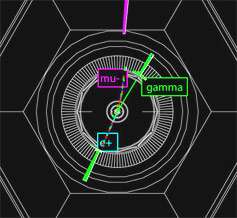A Particle of a Different Flavor?

Just as chocolate ice cream never spontaneously becomes strawberry or vanilla, leptons—electrons, muons and taus—are supposed to conserve their "flavor," or family.
That is, taus can decay into tau neutrinos, but not electron or muon neutrinos, and when a decay produces one kind of lepton, a matching anti-neutrino should come with it. Researchers at SLAC are currently searching for evidence that one lepton breaks these rules. If they succeed, it would pave the way for new physics.
The rules come from the Standard Model of particle physics—but many physicists believe that the Standard Model isn't complete. According to Soeren Prell, current BaBar physics analysis coordinator and a professor at Iowa State University, almost every particle physics measurement is checked against the Standard Model and generally the theory holds up remarkably well.
However, the theory can't explain everything, and several new extensions are waiting in the wings. The search for lepton-flavor-violating processes is one of many efforts to discover violations of the Standard Model.
BaBar's primary objective is to study B mesons, produced by the collision of electrons and positrons. But, in addition, such collisions produce large numbers of tau and anti-tau particles. Members of the BaBar tau analysis working group, led by Swagato Banerjee and Alberto Lusiani, are combing through Babar's copious data to search for lepton flavor violation.
BaBar's data set, which already includes around 440 million tau/anti-tau events, allows the scientists get extra mileage out of the data without added equipment. "BaBar and the Belle experiment in Japan have the biggest pots of taus that exist," Prell said.
The tau is the heaviest of the leptons; it's about 3,500 times heavier than an electron, the lightest. A particle can't gain mass, and so it can only decay into a lighter particle. An electron could not decay into another lepton, and a muon could only decay into an electron. Taus, though, could decay into either, making them an excellent target to examine for potential flavor violation.
BaBar data collection will end in 2008, and Prell expects to have preliminary results next summer, with most final results published by the spring of 2009. But that will hardly be the end of studies on taus. "As long as we have taus, people will look at them," Prell said.
Source: by Amber Dance, SLAC




















